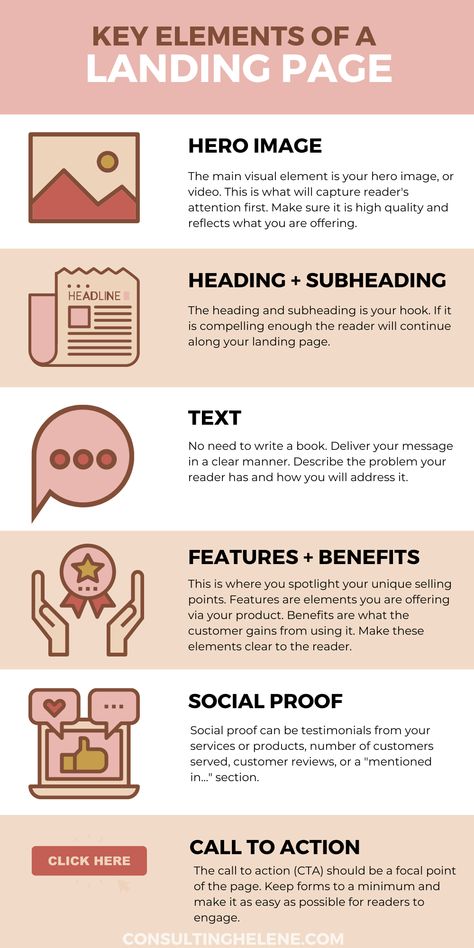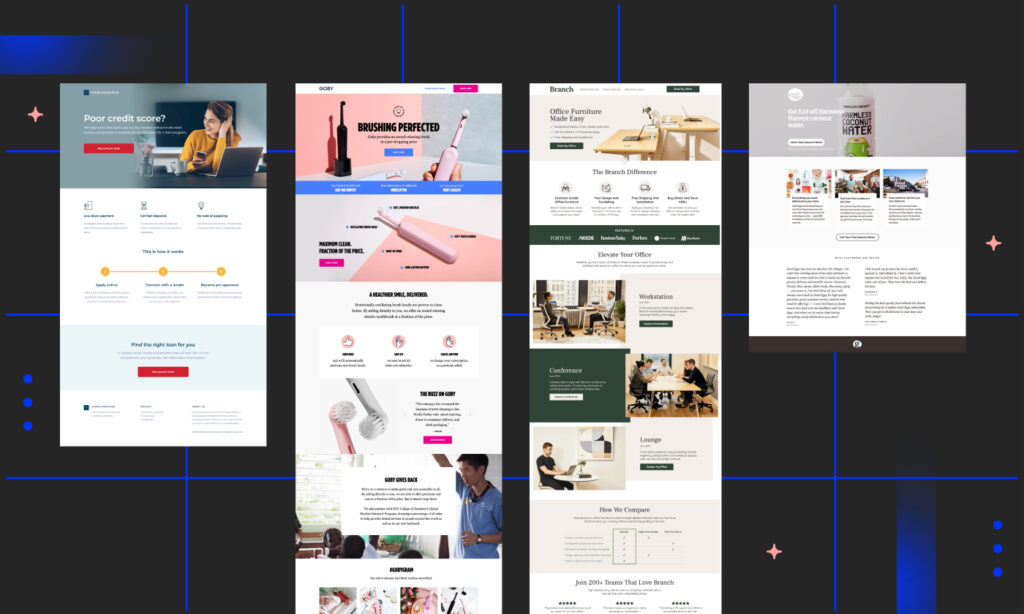In today’s digital landscape, having a well-optimized landing page is essential for driving conversions and achieving marketing goals. Whether you’re aiming to capture leads, promote a product, or increase brand awareness, a high-converting landing page can make all the difference. In this comprehensive guide, we’ll explore the strategies, expert tips, and examples to help you create landing pages that drive results.
A well-designed landing page acts as a dedicated space to capture leads, promote specific offers, and ultimately influence desired actions. This comprehensive guide delves into the world of landing page creation in 2024, equipping you with the strategies, expert tips, and real-world examples to craft high-converting landing pages that resonate with your target audience.
Understanding Landing Pages and Their Importance:
A landing page is a standalone web page distinct from your main website. It’s specifically designed to capture leads, promote a particular offer, or drive a specific action, such as:
- Downloading an eBook
- Signing up for a free trial
- Making a purchase
- Subscribing to a newsletter
Unlike your main website, which caters to a broader audience and offers general information, landing pages are laser-focused on a single goal and targeted towards a specific audience segment. Effective landing pages boast a clear and concise value proposition, compelling calls to action (CTAs), and a user-friendly design that minimizes distractions and encourages conversions.

Benefits of Optimized Landing Pages:
Investing in landing page optimization can deliver significant benefits for your business, including:
- Increased Lead Generation: Optimized landing pages convert visitors into qualified leads at a higher rate, ultimately boosting your sales pipeline.
- Improved Conversion Rates: By eliminating distractions and focusing on a single call to action, landing pages can significantly increase your conversion rates compared to generic website pages.
- Enhanced Brand Awareness: Landing pages can be tailored to highlight specific brand messages and offerings, fostering brand awareness and recognition.
- Measurable Results: Landing pages allow for easier tracking and measurement of campaign performance through conversion metrics and analytics tools.
- Targeted Audience Engagement: Landing pages cater to specific audience segments, enabling personalized messaging and offers that resonate more deeply with potential customers.

Key Strategies for Creating High-Converting Landing Pages:
Here are some cornerstone strategies for crafting high-performing landing pages in 2024:
- Define Your Landing Page Goals: Before you start building, clearly define your desired outcome. Are you aiming to generate leads, drive sales, or promote webinar registrations? Having a clear goal will guide the overall design and messaging of your landing page.
- Identify Your Target Audience: Who are you trying to reach with this landing page? Understanding your target audience’s demographics, needs, and pain points allows for a more personalized approach that resonates with them.
- Craft a Compelling Headline: Your headline is the first impression, so make it count. Use clear, concise language that conveys the value proposition and grabs the visitor’s attention.
- Focus on Benefits, Not Features: Highlight the benefits your offer provides to the customer and how it solves their problems. Don’t just list features; explain how those features translate into real-world value for the visitor.
- Incorporate High-Quality Visuals: Images, videos, and infographics can significantly enhance user engagement and break up text-heavy content. Choose visuals that are relevant to your offer and complement your overall message.
- Prioritize User Experience (UX): Ensure your landing page is mobile-friendly, easy to navigate, and loads quickly. Users have short attention spans, so make it simple for them to find the information they need and complete the desired action.
- Optimize Your Call to Action (CTA): Your CTA is the key to conversions. Make it clear, concise, and positioned strategically on the page. Use action verbs and contrasting colors to make the CTA stand out.
- Leverage Social Proof and Testimonials: Testimonials and customer reviews build trust and credibility. Showcase positive feedback from existing customers to show potential leads the value your offer delivers.
- A/B Test for Continuous Improvement: Don’t settle for what you think works best. A/B testing allows you to compare different versions of your landing page elements and see which ones drive higher conversions.

Expert Tips for Optimizing Landing Pages:
Beyond the core strategies, here are some expert tips to elevate your landing page creation:
- Focus on Mobile Responsiveness: With the increasing number of users accessing the internet on mobile devices, it’s crucial to ensure that your landing page is fully optimized for mobile. Make sure your page adapts seamlessly across different screen sizes and resolutions to provide a consistent and user-friendly experience for mobile users.
- Optimize Page Load Speed: Studies have shown that even a one-second delay in page load time can result in a significant drop in conversions. To prevent visitors from bouncing off your page, prioritize optimizing your landing page’s load speed. Minimize image sizes, enable browser caching, and eliminate unnecessary scripts to ensure fast loading times.
- Utilize Clear and Concise Copywriting: Your landing page copy plays a crucial role in conveying your message and persuading visitors to take action. Avoid using technical jargon or complex language that may confuse or alienate your audience. Instead, focus on clear, concise, and benefit-oriented copy that addresses visitors’ needs and motivations. Use bullet points, subheadings, and short paragraphs to improve readability and highlight key selling points.
- Create a Compelling Visual Hierarchy: Guide visitors’ attention towards the most important elements of your landing page using a clear visual hierarchy. Use contrasting colours, bold typography, and strategic placement to draw attention to your headline, CTA button, and key benefits. Ensure that important information is easily scannable and that visitors can quickly understand the value proposition of your offer.
- Implement A/B Testing: Experiment with different elements of your landing page, such as headlines, CTAs, and imagery, to identify what resonates best with your audience. Conduct A/B tests to compare variations and determine which elements drive the highest conversions. Continuously iterate and optimize your landing page based on data-driven insights to improve performance over time.
- Include Trust Signals: Build credibility and trust with visitors by incorporating trust signals such as customer testimonials, reviews, awards, and certifications. Displaying social proof can help alleviate any doubts or concerns visitors may have and increase their confidence in taking action on your landing page.
- Streamline the Conversion Process: Make it as easy as possible for visitors to convert by minimizing friction and removing unnecessary barriers. Keep your form fields to a minimum and only ask for essential information. Use inline form validation to provide real-time feedback and prevent errors. Consider implementing one-click sign-up options or social logins to streamline the conversion process and reduce friction points.
By incorporating these expert tips into your landing page design and optimization efforts, you can create landing pages that not only capture visitors’ attention but also drive meaningful conversions and achieve your marketing objectives.
what are some common mistakes to avoid when designing a landing page

- Lack of a Clear Call-to-Action (CTA): Ensure that your CTA is prominent and clearly visible on the page. It should be easy for users to understand what action they need to take next.
- Ignoring Mobile Optimization: With the increasing use of mobile devices, it’s crucial to ensure your landing page is optimized for mobile viewing. This includes using responsive design and optimizing images and content for smaller screens.
- Cluttered Design: Avoid overloading your landing page with too much information or too many elements. Keep the design clean and uncluttered to focus users’ attention on the most important information.
- Poorly Written Copy: Ensure that your landing page copy is well-written, engaging, and easy to understand. Avoid jargon and keep sentences short and concise.
- Ignoring User Experience (UX): Prioritize user experience by ensuring your landing page is easy to navigate, with a clear and intuitive layout. This includes using user-friendly design elements, such as drop-down menus and easy-to-use forms.
- Lack of Social Proof: Include customer reviews, testimonials, or other forms of social proof to build trust with potential customers. This can help increase conversions and improve the overall effectiveness of your landing page.
- Neglecting Speed Optimization: A slow-loading landing page can lead to high bounce rates. Optimize your page for speed by compressing images, minifying code, and using a content delivery network (CDN) to serve content from a location close to your users.
- Ignoring SEO: Ensure that your landing page is optimized for search engines by using relevant keywords, meta descriptions, and other on-page SEO techniques. This can help increase organic traffic to your page.
- Lack of A/B Testing: Regularly test different elements of your landing page, such as headlines, images, and CTAs, to determine which versions perform best. This can help you optimize your page for better conversion rates.
- Not Considering Accessibility: Ensure that your landing page is accessible to all users, including those with disabilities. This includes using alt text for images, providing closed captions for videos, and following WCAG guidelines for web accessibility.
By avoiding these common mistakes and focusing on user experience, clear calls-to-action, and effective design, you can create a landing page that drives conversions and achieves your content marketing goals.
Design and Structure Examples of Landing Pages:

- Casper Landing Page:
- Clean and minimalist design with a focus on the product.
- Clear value proposition and benefits highlighted.
- Testimonials and trust signals build credibility.
- Prominent call-to-action (CTA) encourages conversions.
- HubSpot Landing Page:
- Visually appealing design with eye-catching graphics.
- Concise copy highlighting the benefits of the product.
- Free trial offer with a simple sign-up form.
- Clear and prominent CTA above the fold.
- Unbounce Landing Page:
- Engaging visual elements showcasing product features.
- Benefit-oriented copy that addresses visitor pain points.
- Social proof in the form of customer testimonials.
- Clear and compelling CTA that stands out.
Case Studies of Successful Landing Pages:
- Shopify:
- Shopify’s landing page for their e-commerce platform saw a 56% increase in conversions after implementing a simplified design and clearer value proposition.
- Squarespace:
- Squarespace’s landing page for their website builder tool experienced a 40% boost in sign-ups after adding customer testimonials and trust badges.
- Mailchimp:
- Mailchimp’s landing page for their email marketing software achieved a 30% increase in conversions by optimizing the CTA placement and using dynamic content based on user behaviour.
Landing pages examples:
eBook landing page example

Food landing page example

SaaS product landing page example

The Future of Landing Pages
Looking Ahead: The Future is Personalized and Dynamic.
The future of landing pages is unquestionably personalized and dynamic. AI will play a vital role in tailoring content, optimizing elements, and crafting truly engaging experiences for each individual visitor. By embracing these advancements and focusing on personalization, businesses can build high-converting landing pages that deliver exceptional user experiences and drive sustainable growth.
- Content marketing is a crucial strategy involving creating valuable content to attract and retain an audience.
- Strategies for 2024 include personalization, video marketing, influencer marketing, interactive content, and voice search optimization.
- A/B testing helps identify best-performing content, improve conversion rates, and reduce bounce rates.
- UX testing enhances usability, accessibility, and overall user experience of digital content.
- Emerging trends in 2024 include hyper-personalization, visual storytelling, micro-influencer partnerships, podcasting, and augmented reality.
- A/B testing examples include headline optimization, call to action buttons, and landing page designs.
- UX testing examples involve navigation improvements, mobile responsiveness, and accessibility assessments.
Conclusion:
Optimizing landing pages is crucial for driving conversions and achieving marketing goals in today’s digital landscape. By following the strategies, expert tips, and examples provided in this guide, businesses can create landing pages that effectively engage visitors, communicate value, and encourage action. As technology continues to evolve, the future of landing pages will see further advancements in personalization, automation, and user experience. By staying informed and embracing innovative techniques, marketers can ensure their landing pages remain effective and competitive in the years to come.


Leave a Reply